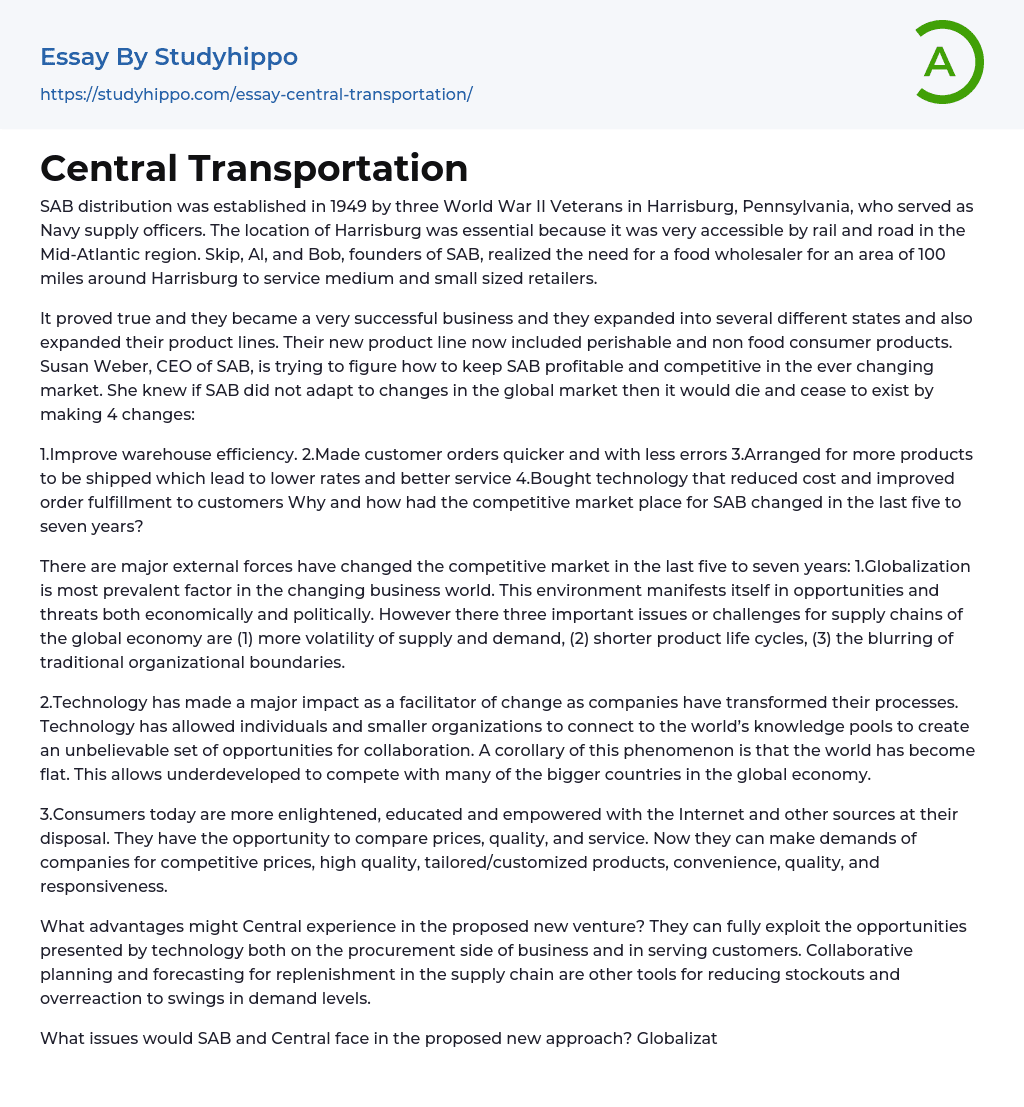SAB distribution was established in 1949 by three World War II Veterans in Harrisburg, Pennsylvania, who served as Navy supply officers. The location of Harrisburg was essential because it was very accessible by rail and road in the Mid-Atlantic region. Skip, Al, and Bob, founders of SAB, realized the need for a food wholesaler for an area of 100 miles around Harrisburg to service medium and small sized retailers.
It proved true and they became a very successful business and they expanded into several different states and also expanded their product lines. Their new product line now included perishable and non food consumer products. Susan Weber, CEO of SAB, is trying to figure how to keep SAB profitable and competitive in the ever changing market. She knew if SAB did not adapt to changes in the global market then it would die and cease to exist by making 4 chan
...ges:
1.Improve warehouse efficiency. 2.Made customer orders quicker and with less errors 3.Arranged for more products to be shipped which lead to lower rates and better service 4.Bought technology that reduced cost and improved order fulfillment to customers Why and how had the competitive market place for SAB changed in the last five to seven years?
There are major external forces have changed the competitive market in the last five to seven years: 1.Globalization is most prevalent factor in the changing business world. This environment manifests itself in opportunities and threats both economically and politically. However there three important issues or challenges for supply chains of the global economy are (1) more volatility of supply and demand, (2) shorter product life cycles, (3) the blurring of traditional organizational boundaries.
2.Technology has
made a major impact as a facilitator of change as companies have transformed their processes. Technology has allowed individuals and smaller organizations to connect to the world’s knowledge pools to create an unbelievable set of opportunities for collaboration. A corollary of this phenomenon is that the world has become flat. This allows underdeveloped to compete with many of the bigger countries in the global economy.
3.Consumers today are more enlightened, educated and empowered with the Internet and other sources at their disposal. They have the opportunity to compare prices, quality, and service. Now they can make demands of companies for competitive prices, high quality, tailored/customized products, convenience, quality, and responsiveness.
What advantages might Central experience in the proposed new venture? They can fully exploit the opportunities presented by technology both on the procurement side of business and in serving customers. Collaborative planning and forecasting for replenishment in the supply chain are other tools for reducing stockouts and overreaction to swings in demand levels.
What issues would SAB and Central face in the proposed new approach? Globalization and deregulation have made SAB much more vulnerable in its regional marketplace and much more insulated against larger competitors. These change drivers represent both opportunity and threats for SAB, as well as for other businesses large and small.
- Anthropology essays
- Audience essays
- Charity essays
- Cultural Competence essays
- Emile Durkheim essays
- Gender Roles essays
- Generation essays
- Globalization essays
- Interpersonal Relationship essays
- People essays
- Race essays
- Social Change essays
- Social Class essays
- Social Movement essays
- Social Science essays
- Social Status essays
- Social Stratification essays
- Society essays
- Sociological Imagination essays
- Sociological Perspective essays
- Sociological Theories essays
- Stereotypes essays
- Web Dubois essays
- American Dream essays
- Barriers To Entry essays
- Capitalism essays
- Central Bank essays
- Compensation essays
- Consumerism essays
- Economic Development essays
- Economic Growth essays
- Economic Inequality essays
- Economic System essays
- Economy essays
- Employment essays
- Export essays
- Finance essays
- Free Trade essays
- Gross Domestic Product essays
- Human Development essays
- Income Inequality essays
- Industry essays
- Inflation essays
- International Business essays
- International Trade essays
- Macroeconomics essays
- Materialism essays
- Max Weber essays
- Microeconomics essays
- Minimum Wage essays




